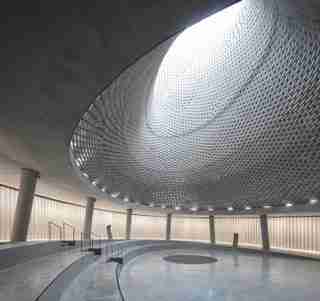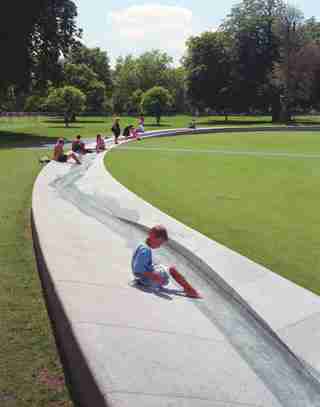December 05,2022
A New Book Explores the Architectural Power of Memorials
by David Stewart
Few architectural works are as meaningful—and often as hotly debated—as a memorial. The structures have tremendous power, evoking grief, anger, understanding, and sometimes even hope. In his new book, In Memory Of: Designing Contemporary Memorials (Phaidon, $70), author Spencer Bailey explores and contextualizes over 60 memorials from around the world, examining the evolution of the modern memorial and the different forms they take, from landscape art to museums to hidden tributes. “What makes memorials fascinating is that, no matter how you look at them, they’re loaded,” writes Bailey in his deeply personal introduction. “Various social, cultural, financial, and political powers bring them into this world and, once built, such powers continue to shift their meanings and interpretations throughout time.” From Maya Lin’s Vietnam Veterans Memorial to Snøhetta and Michael Arad, Peter Walker and Davis Brody Bond’s 9/11 Memorial and Museum to Peter Eisenman’s Memorial to the Murdered Jews of Europe, these designs have shaped our culture and our consciousness and become indelible parts of their locations. Read on to explore some of the powerful architectural masterpieces featured in the book.

National Memorial Hall for Israel’s Fallen (Jerusalem, Israel)
Completed by Kimmel Eshkolot Architects in 2017, the National Memorial Hall for Israel’s Fallen is set in the hillside of Mount Herzl and features a wall of names comprising over 23,000 bricks, each with the name of a fallen soldier, the date of their death, and space for a candle. The commemorative bricks surround the central void, which is flooded with light by the oculus at the top of a funnel-shaped ceiling.

100-Step Garden at Awaji Yumebutai (Awaji, Japan)
Tadao Ando designed this memorial to the victims of the Great Hanshin earthquake, which killed more than 6,000 people in 1995, at Awaji Yumebutai, a conference center and hotel development. One hundred flower beds, a 33-foot-wide waterfall, and sets of concrete stairs are set into the hillside at the highest point of the mixed-use complex, which includes an amphitheater, church, restaurants, and site for tea ceremonies.

Diana Memorial Fountain (London)
Located in Hyde Park, this oval-shaped granite fountain, which opened in 2004, pays tribute to the late Princess of Wales. Water cascades through Gustafson Porter + Bowman’s design and slows to a stop at the basin, creating a calming, reflective space.
Sousse and Bardo Memorial (Birmingham, England)
Titled Infinite Wave, architect George King’s 2019 memorial to the 31 British nationals killed in terrorist attacks in Tunisia in 2015 was inspired by flowing water. The structure is made up of 31 steel tubes that create a “wavelike arch” and is surrounded by concentric circles of granite. The shape of the memorial changes based on the vantage point, resembling a set of wings from the side and an eye from above.
Memorial to the Victims of Violence in Mexico (Mexico City)
Memorializing lives lost in Mexico’s drug war, local firm Gaeta-Springall Arquitectos’s 2012 Memorial to the Victims of Violence in Mexico used CorTen steel, water, light, and trees to create a poetic, impactful experience. Quotes on memory, violence, and other topics are inscribed on many of the 70 steel panels that are set vertically and horizontally throughout the space. A 13,000-square-foot reflecting pool is partially topped with grates, allowing visitors to walk across the water.
New York City AIDS Memorial (New York City)
Completed in 2016, the New York City AIDS Memorial is located beside the former site of St. Vincent’s Hospital, which was at the center of the AIDS epidemic. The open and airy design by Studio AI Architects was selected from 475 entries in a design competition. The centerpiece of the memorial is a white steel–and–aluminum pavilion, which covers a fountain, benches, and an installation by artist Jenny Holzer.
National Memorial for Peace and Justice (Montgomery, Alabama)
Designed by MASS Design Group, the National Memorial for Peace and Justice pays tribute to the 4,400 Black Americans murdered in lynchings from 1877 to 1950. Six-foot-tall CorTen steel slabs hang from the ceiling of the pavilion, each representing one of the 816 U.S. counties where a lynching took place. Established by human rights lawyer and Equal Justice Initiative executive director Bryan Stevenson, the memorial was designed to change over time, as the respective counties claim their corresponding slabs that surround the pavilion and place them in their communities following an acknowledgment and reconciliation process.
Smithsonian National Museum of African American History and Culture (Washington, D.C.)
The Smithsonian National Museum of African American History and Culture was established by an act of Congress in 2003 and opened in 2016, almost a century after it was first conceived. The museum, which is located on the National Mall, was designed by David Adjaye—lead designer for the Freelon Adjaye Bond SmithGroup—and is home to galleries displaying over 3,000 artifacts. The Contemplative Court, shown here, features a cylindrical fountain that surrounds a skylight and pours into a pool below.
National Holocaust Monument (Ottawa, Ontario)
Daniel Libeskind’s design for Ottawa’s National Holocaust Museum consists of six concrete triangles—a reference to the yellow Star of David that Jews were forced to wear and the triangular identification badges that were mandatory for other victims, such as gays and lesbians, Sinti and Roma, and Jehovah’s Witnesses. Large-scale photographs by Edward Burtynsky are reproduced on the concrete walls, creating a haunting and moving display.
The Invisible Monument: 2146 Stones – Monument Against Racism (Saarbrücken, Germany)
Completed in 1993, Jochen Gerz’s The Invisible Monument memorializes the 2,146 Jewish cemeteries that existed before the Third Reich. Gerz and his students at the School of Fine Arts in Saarbrücken secretly removed and temporarily replaced cobblestones from the square outside the former home of the Gestapo. They inscribed the names of the cemeteries and reinstalled them face down, creating an invisible underground memorial. Despite an initial public uproar, Gerz eventually got approval for the work and Parliament renamed the area Square of the Invisible Monument.
In Memory Of: Designing Contemporary Memorials (Phaidon, $70)






